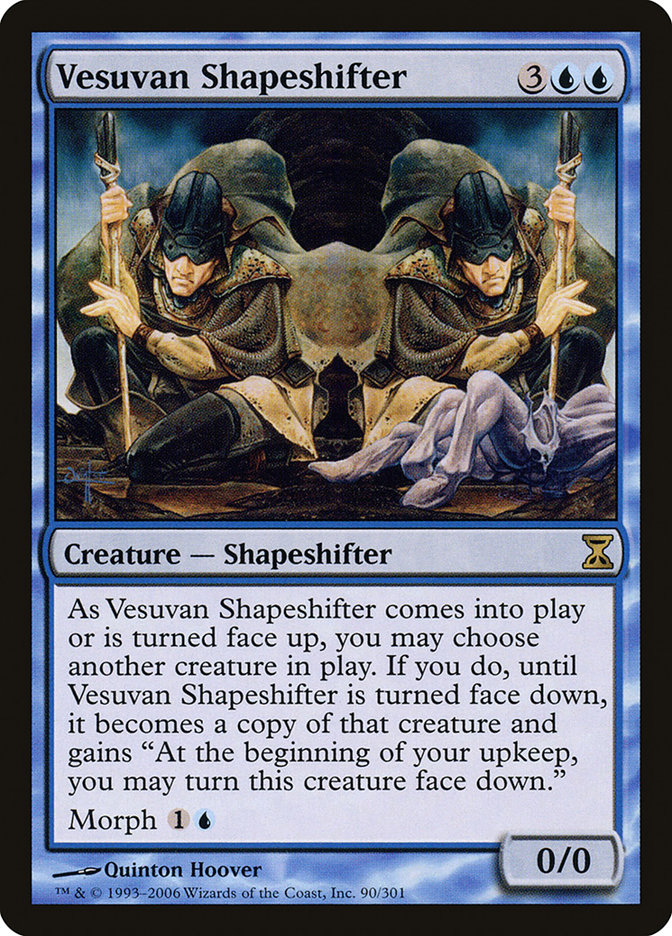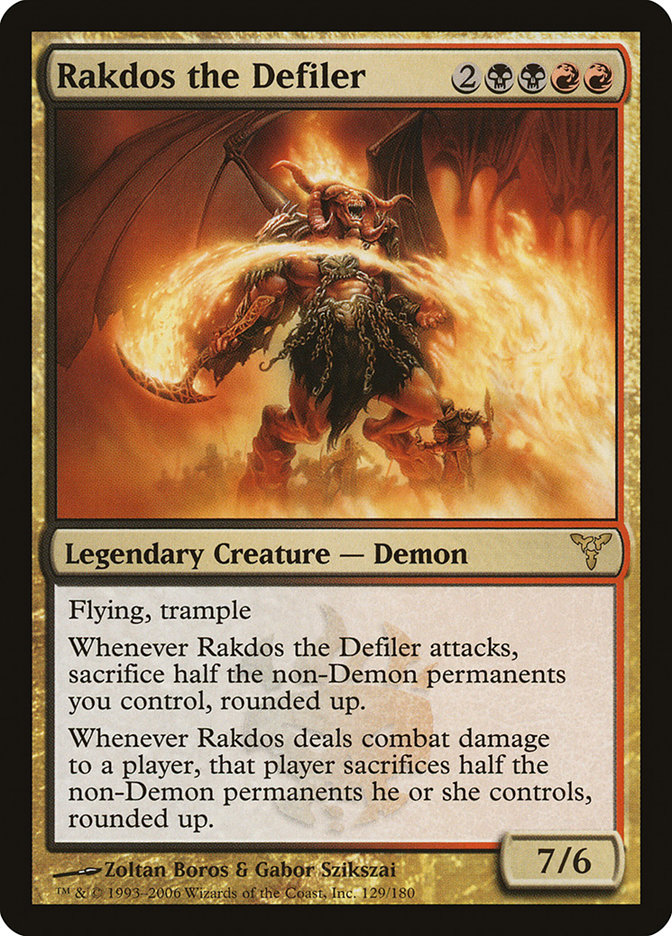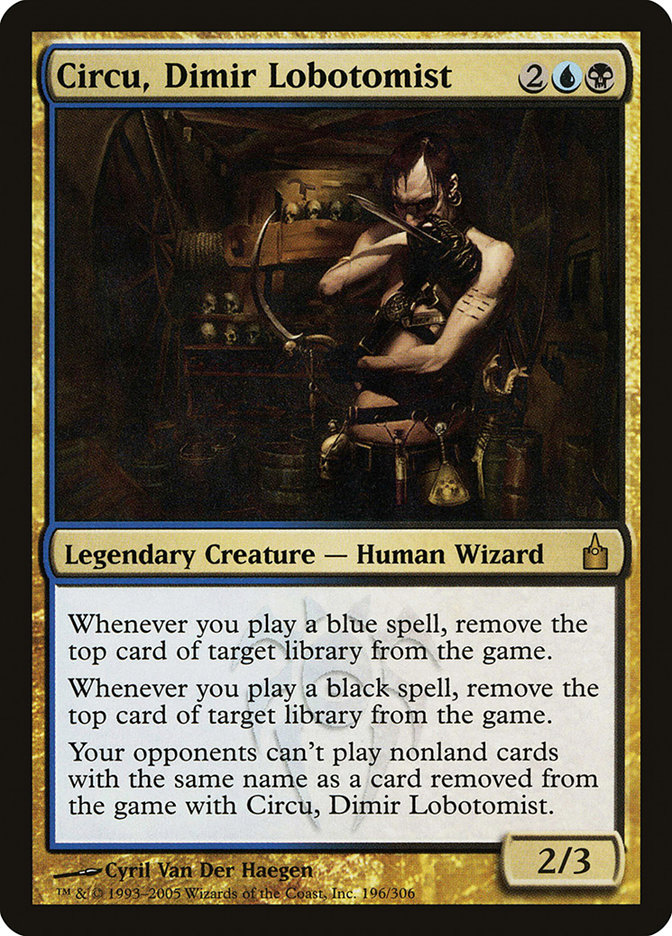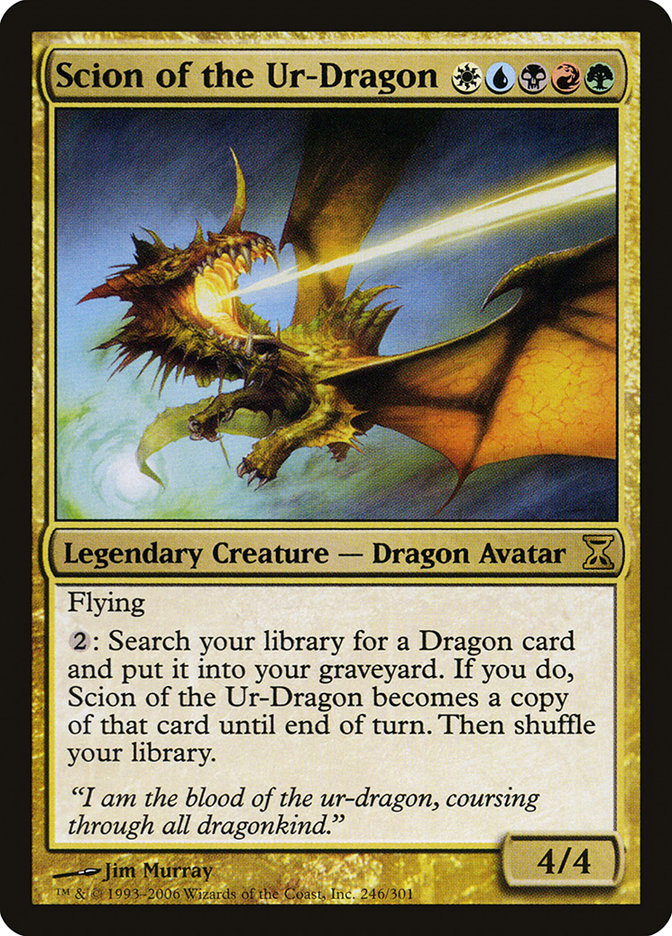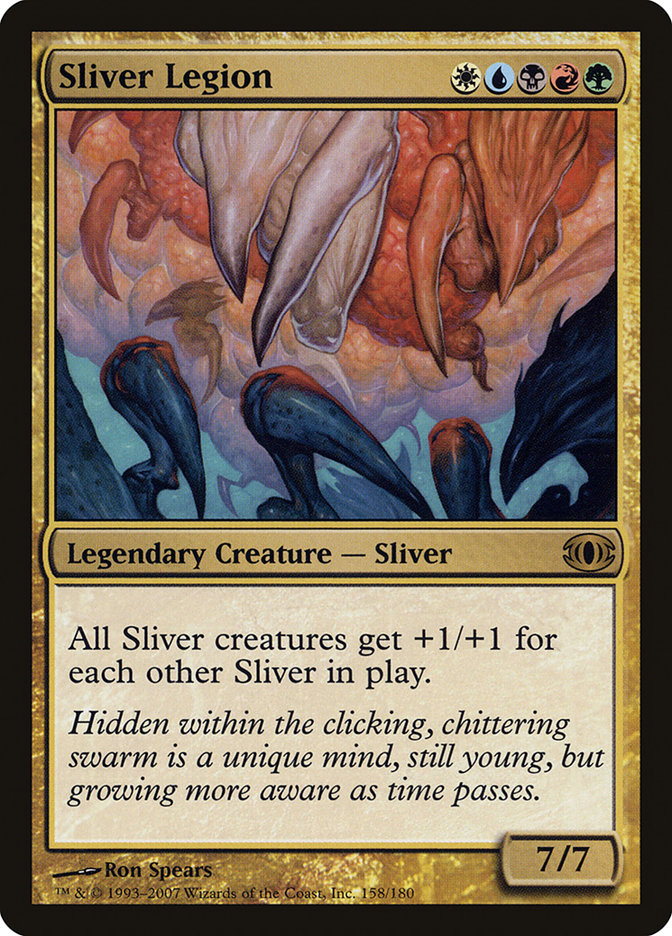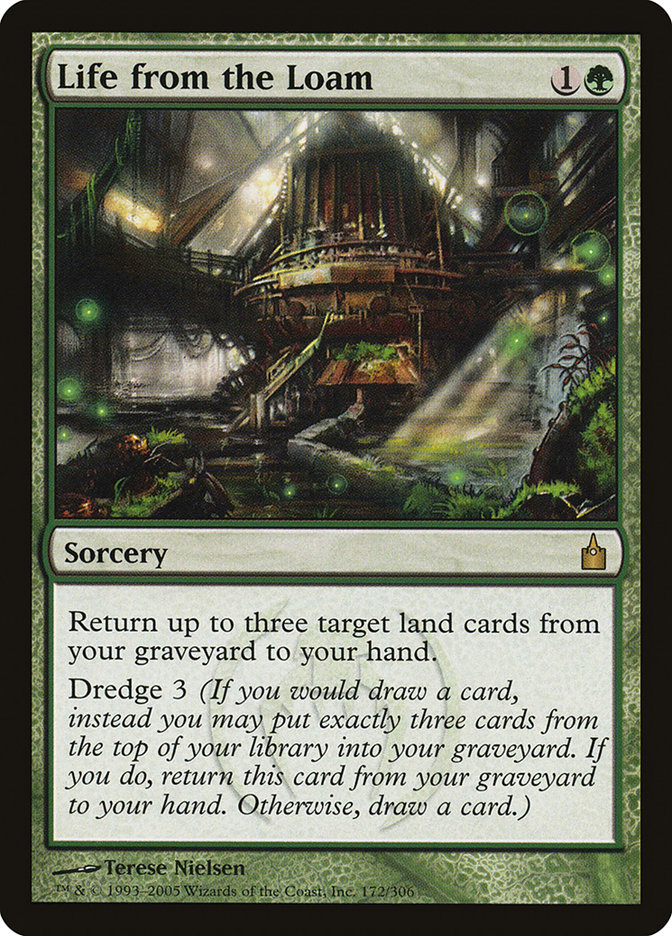The second match of the Battle Of The Blocks Top 4 takes place today, pitting the most beloved block in Magic history, Ravnica, against a block that’s steeped in so much nostalgia it should come in an orange video cassette tape in Time Spiral block. Coming off a first-round bye, Ravnica block was thrown into the middle of the Weatherlight saga as it challenged Tempest block in the Top 16. Tempest’s amazing suite of staples almost capsized Ravnica early on in the competition, but Ravnica’s stronger legends and mechanics snuck it by a surprisingly fierce Tempest block to face the Commander product in the Top 8.
The Commander product was a heavy favorite to win this competition and once again gave Ravnica block a great match, throwing the best assortment of legendary creatures in the Battle Of The Blocks at the City of Guilds. But Ravnica block countered this heavy assault with an assortment of strong staples, commanders, and mechanics to win the battle with its superior all-around strength. In this Top 4 fight, Ravnica block looks to once again take its all-around strength and steamroll over the block its up against.
The block standing in Ravnica’s way to the finals is the unexpectedly resilient Time Spiral block. Time Spiral block’s first challenge came in the Top 16 when the Japanese-flavored Kamigawa block ruthlessly attacked it with some of the coolest mechanics to grace Magic, ninjutsu and the appropriately named epic. But when it comes to awesome mechanics, no one can touch Time Spiral block, which revisited tons of old mechanics like flanking, cycling, and madness as well as created the innovative split second and suspend.
Time Spiral block outleveled the feudal Kamigawa and sent them back to the Stone Age to advance to the Top 8. Shards of Alara was there to meet the travelers through time and put up a knock-down drag-out fight, with its tried and true multicolor theme going head-to-head with Time Spiral block’s intrepid card design. Time Spiral block defeated the tricolored-focused Shards of Alara block with its premier staples and overwhelmed its combined forces for a Top 8 berth!
This is the last battle in the Top 4, with the winner going on to face #1 seed Lorwyn-Shadowmoor block.
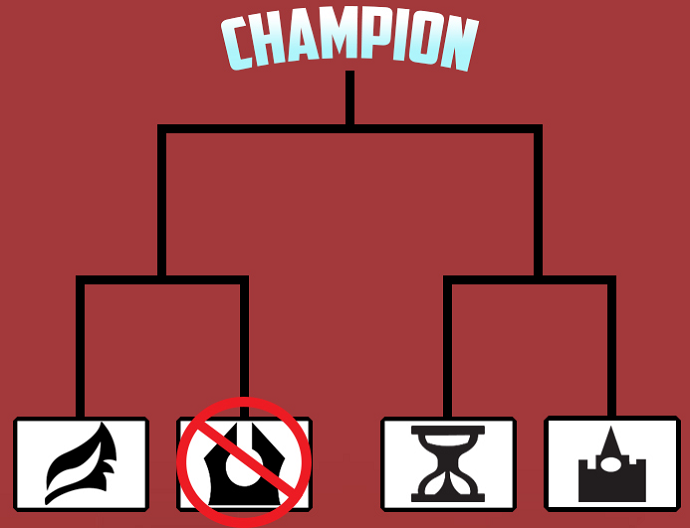
Staples
Staples From Time Spiral Block
1) Damnation
2) Gauntlet of Power
3) Coalition Relic
4) Return to Dust
5) Harmonize
6) Venser, Shaper Savant
7) Terramorphic Expanse
8) Vesuvan Shapeshifter
9) Krosan Grip
10) Draining Whelk
Now that the Staples section showcases the Top 10 cards instead of the Top 5, it reveals which blocks are more top heavy in the staples section and which have an even spread across the sets. Delving into an extra five cards only strengthens Time Spiral block’s presence in the competition, with Commander stalwarts Vesuvan Shapeshifter and Venser, Shaper Savant making their way on the list. Vesuvan Shapeshifter was more prevalent before the legendary rule change when it could be used as protection from hasty commanders, but it still performs as a utility Clone that can always be the best creature on the battlefield.
The color-morphing Planar Chaos set is responsible for the color-shifted draw spell Harmonize that has seen more play than its blue cousin Concentrate due to the low quantity of effective card draw in green. The instant classic Damnation is also from Planar Chaos and owes its big brother Wrath of God for its low mana cost and incredible power in a format dominated by creature combat.
Staples From Ravnica Block
1) Shock Lands
2) Signets
3) Condemn
4) Karoo Lands
5) Putrefy
6) Mortify
7) Angel of Despair
8) Doubling Season
9) Faith’s Fetters
10) Life from the Loam
A common theme that has developed for Ravnica block is its top-heavy staples section. The influx of great mana fixing from Ravnica block is important for a format like Commander that is littered with multicolored decks that are trying to extend their mana bases to the limit. But when we hit the lesser played spot removal in Putrefy and Mortify, the quality of spells from this set starts to slowly decline for this category.
The Staples section celebrates the spells that hold the format together as the building blocks of most Commander decks, and Life from the Loam and Doubling Season, although incredibly strong cards in the Strategies section, are lackluster in this section. The introduction of improved removal in the sets following Ravnica block is what tarnishes the prestigious listing of cards in this section, demoting an A section for the City of Guilds to a better than average B+.
Verdict: Although a B+ is never something to scoff at, Time Spiral’s litany of amazing staples conquers Ravnica block’s great mana fixing.
Commanders
Ravnica block is all about establishing the guilds as the representation of the color pairs of Magic, and one of the ways they accomplished this task was the legendary guild leaders and champions. The leaders and champions of the guilds were the only legendary creatures on the plane of Ravnica, presenting Wizards of the Coast with an interesting conundrum. Wizards wanted these important creatures to bleed the ideologies of their guilds from every pore of their card frames but still see some play in the world of Constructed.
This flavor-first design led to an equal amount of hits and misses, as awesome card designs like Rakdos the Defiler demolished the flavor test but fell way under the bar for playability. This is the story for most of the legends in Ravnica block; cards like Chorus of the Conclave; both Boros legends; Circu, Dimir Lobotomist; and even my favorite general, Borborygmos, are very flavorful but rarely make the cut when it comes to choosing the leader of the other 99 cards in the Commander deck.
The Ravnica block legends aren’t all style and no substance since some of these commanders compliment their flavor with considerable power. Both Niv-Mizzet, the Firemind and Momir Vig, Simic Visionary still make an impact on the format years after their printing and look to remain prominent in the Commander metagame for a long time to come.
Time Spiral block possesses the greatest lineup of commanders for the Battle Of The Blocks competition now that the Commander product was unceremoniously knocked out by Ravnica block. Going beyond the historically significant Planar Chaos wedge Dragons, Time Spiral block plays host to two of the most unique five-color generals.
Scion of the Ur-Dragon is a five-color Dragon lord whose shapeshifting ability lets deckbuilders create a hybrid tribal/toolbox deck that revolves around the activated ability of this undersized Dragon. Because Scion of the Ur-Dragon’s ability puts the Dragons into the graveyard, reanimation effects are commonplace in this deck, adding a resiliency that is usually underutilized in tribal Dragon decks. Plus if Scion of the Ur-Dragon gets tucked to the bottom of the library, the deck is still filled with bloodthirsty Dragons who would love nothing more than to burn down the countryside and destroy all opponents.
Sliver Legion is the other five-color general to slither its way out of Time Spiral block. Just like Scion of the Ur-Dragon, Sliver Legion focuses on a casual-friendly tribe, this time the lord-centric Sliver tribe, and is mostly cast by players who want to be more aggressive with their Sliver army.
Verdict: The guild leaders and champions of Ravnica block couldn’t withstand the legends from Time Spiral block and lose this section handily. The importance of the Planar Chaos Dragons during the beginning of the format along with other heavily played commanders from Time Spiral block like Jhoira of the Ghitu send Ravnica packing in another section of this battle.
Strategies
Time Spiral’s chief contributions to Commander lie within the tribal, blink, and enchantment builds that are popular in the format. Tribal decks, especially Slivers and Dragons, can look to Time Spiral block for spells to power up their token production and put the creature count over the top. Enchantment decks grabbed a draw engine in Mesa Enchantress, and Daybreak Coronet and Arcanum Wings brought both utility and card advantage to Auras strategies.
Momentary Blink brought creature-bouncing fun to Standard and after wreaking havoc for six months transferred to Commander to annoy another set of Magic players. Momentary Blink Commander decks also grabbed Venser, Shaper Savant and Draining Whelk in Time Spiral block for the most nefarious thing that blink decks do: counter spells by blinking these rare blue creatures. The final strategy that’s worth mentioning, Storm, owes a large amount of its success in Commander to Time Spiral block. Two of the best kill cards, Empty the Warrens and Ignite Memories, are from Time Spiral block, and without good kill spells, Storm would fizzle out of existence.
The greatest contribution that Ravnica block brings to the format is its ten mechanics that help support multiple different strategies throughout Commander. Doubling Season leads the charge in bringing some great +1/+1 counter cards to Commander, with Novijen Sages, Cytoplast Manipulator, and the entire graft mechanic being solid inclusions in any deck that wants to win the game with a myriad of dice. Life from the Loam powers through popular Legacy decks as a constant source of card advantage, something Commander decks have been doing with the two-mana sorcery for years.
Other notable dredgers from the Golgari guild are Golgari Grave-Troll and Stinkweed Imp, two creature spells that help fill the graveyard at a surprisingly fast speed. Commander commonly embraces the wacky side of Magic, and the Izzet guild brought two of the most insane cards in existence, Warp World and Eye of the Storm, into the Commander format. I’m not entirely sure if that’s a good thing or a mistake. All I know is that people love their chaos cards, and the Izzet guild is there to thank!
Verdict: Ravnica block takes this one from Time Spiral block with its streamlined mechanics beating the scatterbrained spells from Time Spiral, granting it its first win of the night.
Flavor
The weak points of these blocks lie in the execution of their flavor. Ravnica block gets so bogged down with trying to slap a face onto each of the color pairs that it fails to anchor the player in a story to give the places and people they meet meaning. This causes Ravnica block to play out like a slideshow of awesome vistas and interesting strangers that lack any resonance with the player.
Ravnica block did accomplish its main goal in representing each color pair in Magic, creating a basis for future card design and player expectation of those colors. When a player sees a red-green card, they expect it to play like the Gruul cards from Ravnica block whether or not it’s from the city-strewn plane. This is an important accomplishment for the continuity of Magic design, but when it comes to Commander, being able to call a deck Boros or Dimir fails to add true significance to the format.
Time Spiral block is also unsuccessful in establishing a narrative throughout its three sets. The time-bending nature of new mechanics split second and suspend draw the player into a block about twisting time to the planeswalker’s will but fails to deliver a story to accompany the litany of cards arriving from the past. This turns these cool mystery characters into non sequiturs that aren’t linked to the rest of the cards within the block. This lack of cohesion within the cards from Time Spiral creates a sterile feel to the entire block and tempers its reception at a Commander table.
The only advantage Time Spiral has over Ravnica in this category is that it relies on the past of these strange cards to create a flavor resonance with the player. A card like Viscid Lemurs makes no sense to a player looking at Time Spiral as a whole, but on an individual card level the black spirit is a joking nod to the previous Hyalopterous Lemure from Ice Age. By playing on the nostalgia factor of popular cards from the past, the creators of Time Spiral block managed to develop a block devoid of cohesion but filled with flavor for players that take the time to delve into Magic’s bygone eras.
Verdict: These blocks both make the same mistake of trying to accomplish a design goal first and building a world second. Time Spiral block wins this section by creating cards that appeal to established players’ nostalgia and ask newer players to discover Magic’s past.
The Bad
The only card on the banned list between these two blocks is the Grand Prix-winning Protean Hulk. Protean Hulk’s search effect is just too strong for a format that’s optimized to play games of seven turns or more and would be heavily exploitable in today’s graveyard recursion and value focused metagame. Each of these blocks features a despised Izzet general in Jhoira of the Ghitu and Niv-Mizzet, the Firemind. These legends are constantly focused on in multiplayer Commander games due to their low interactivity and consistent combo finishes through a single card like Curiosity or suspended Eldrazi and Decree of Annihilation.
Verdict: The only true detriment to the format was "win the game on the spot" card Protean Hulk, which gives Time spiral the win in this category.
Final Verdict
Coming up short in this battle, Ravnica block just couldn’t handle the amazing staples and commanders from Time Spiral block. Even though it snagged the Strategies section, the City of Guilds couldn’t compare to the temporal -centric Time Spiral block and loses this battle.
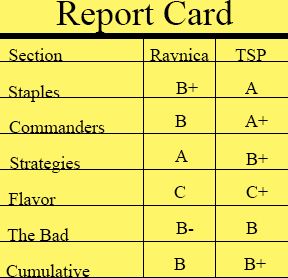
We now have our two finalists: Time Spiral block and Lorwyn-Shadowmoor block! Is another upset in the works or will the top seed win once again to be crowned the greatest block for Commander? Stop by next week to find out!

